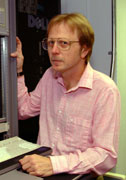
Dr. Krawetz awarded $1 million for multi-institutional center to study pollutants' effect on sperm
Just as DNA fingerprints can trace a person to the scene of a crime, RNA fingerprints can provide clues to a man's infertility by identifying the level of sperm-affecting pollutants, including PCBs (polychlorinated biphenyls), in his system. This is a particularly important issue in Michigan, which has a large sport-angler population that consumes PCB-contaminated fish.
With a three-year, $1 million grant from the Michigan Economic Development Corporation, a new multi-institution Center for Excellence hopes to turn the recent discovery of sperm in the genetic material called RNA into a variety of screening tests that will check men for PCBs, pesticides and similar pollutants that are believed to impede fertilization and/or normal fetal development, according to center director Stephen Krawetz, Ph.D.
Dr. Krawetz, Charlotte B. Failing Professor of Obstetrics and Gynecology in Wayne State University's School of Medicine, announced the link between sperm RNA and healthy births in the May 13, 2004, issue of the journal Nature.
"Following that work, it became quite obvious to us that the RNAs are likely to provide reasonable markers of paternal insult. In other words, if something has happened to Dad before he conceives, it's really going to be carried by the sperm and by these RNA messages," he said.
Researchers at the WSU School of Medicine and the center's other two partner institutions — Michigan State University and the Van Andel Research Institute — are now beginning to compare the sperm of men who have and haven't been exposed to these pollutants, which are collectively called oganochlorinated compounds.
"Here in Michigan, we have a huge population of sport fisherman, and some 3 million individuals in this state eat sport-caught fish. Compared to the PCB level viewed as normal, the levels in the real avid fisherman can be as high as 10-fold that amount," Dr. Krawetz said. "This assay will give us a way to determine whether consumption of the organochlorine-contaminated fish are having an effect on births."
Already, he noted, numerous reports have associated such pollutants with increased numbers of miscarriages, low sperm counts and reduced in vitro fertilization rates.
Once developed, the fertility-screening tests will have a number of applications, such as helping a couple plan conception, he said. "If we can identify alterations in the patterns of these RNAs that are expressed between an affected vs. a normal individual, then that clearly gives us a good diagnostic screen to tell a couple in a clinician's office, 'Well, this might not be a good time for you to conceive.'"
Since men turn over a completely new batch of sperm every 60 days or so, the level of PCBs van vary widely from month to month. "That means that such a test would be able to monitor the elimination of these toxic compounds or the loss of their effect until he exhibited a normal sperm profile," Dr. Krawetz said.
Besides Dr. Krawetz, center researchers include Michael Diamond, M.D., WSU associate chair of obstetrics and gynecology and director of the Division of Reproductive Endocrinology and Infertility; James Resau, of the Van Andel Research Institute; and Julie Wirth, of Michigan State University.